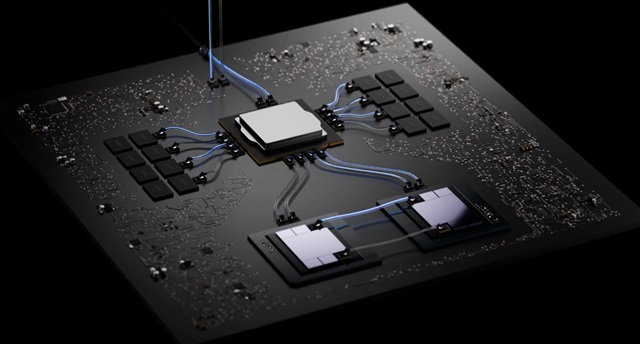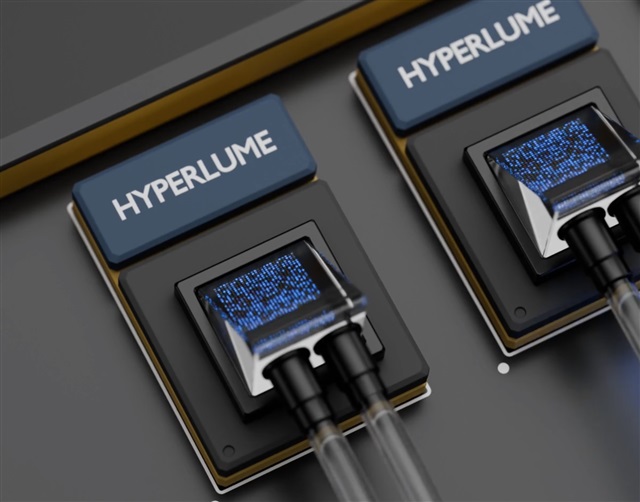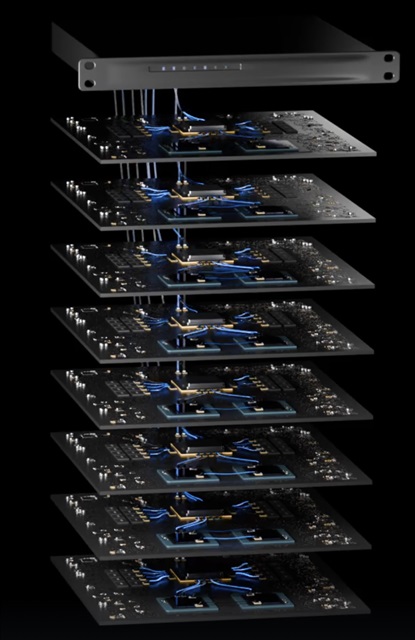Ottawa-based deep-tech startup Hyperlume is poised to disrupt the landscape of AI and high-performance computing with its innovative optical interconnect solutions. The company is tackling the growing challenges of heat and energy consumption in AI data centers by offering a short-distance optical communication solution that utilizes micro-LEDs for data transmission.
Mohsen Asad, Hyperlume's CEO and Co-founder, explains, "The most urgent challenges for AI infrastructure are data transfer bandwidth and energy consumption. We are focused on short-distance optical communication, and are pioneering a new class of ultra-fast, low power based optical interconnects - specifically built for next-generation AI and high-performance computing networking."

Credit: Hyperlume
Innovative technology and key advantages
While micro-LEDs have faced adoption challenges in display technology due to cost, Hyperlume is taking a different approach. The startup is developing micro-LEDs specifically for short-distance communication, enabling high-speed data transfer at very low power orders of magnitude better than active electrical interconnects in terms of energy per bit.
A key differentiator is Hyperlume's Complementary Metal-Oxide-Semiconductor (CMOS) compatible technology, which allows integration of their optical engine into the system package similar to integrating a standard Application Specific Integrated Circuits (ASIC) chip. This makes it naturally scalable and cost-effective, especially at volume.
Additionally, as a key advantage, their micro-LED interconnects are technology node agnostic and can be fabricated at advanced nodes like 3nm or 5nm, or with more conventional nodes, which gives system architects much more flexibility in terms of cost-performance trade-offs.
The company has also patented an optical architecture to couple light directly from micro-LEDs into fiber bundles or optical waveguides, eliminating the need for bulky optics and active alignments reducing packaging complexity and cost.
Furthermore, Hyperlume's technology offers customers flexibility in choosing performance and cost, as the interconnects can be built on different CMOS nodes. The startup's innovations span micro-LED structures, drivers, photo-detectors, and optical coupling, setting them apart from competitors.
Altogether, our approach offers a scalable path to low-cost, wafer-level manufacturing, especially when paired with advanced wafer-level packaging, and wafer-level optics
"Hyperlume isn't just building state-of-the-art technology, our approach offers a scalable path to low-cost, wafer-level manufacturing, especially when paired with advanced wafer-level packaging, wafer-level optics, and passive alignment which we're co-developing with partners. ," says Mohsen, " We're enabling a technology on how data moves inside next-gen compute systems. That's the real competitive edge. We are trying to make sure the technology that we're developing can be easily implemented in AI infrastructure with no hurdles."
Targeting a rapidly expanding market
Hyperlume is targeting the massive and fast-growing market for optical interconnects, fueled by increasing demand for AI and high-performance computing. By 2028, the optical interconnect market is projected to exceed $20 billion, largely driven by the exponential growth in AI model size and bandwidth requirements.
Hyperlume's microLED-based optical interconnects could potentially capture a multibillion-dollar segment, especially in areas where power efficiency, density, and reach are critical—like pluggable active optical cable (AOC), GPU-to-GPU scale-up, or chiplet communication. Some estimates suggest that sales of AOCs are projected to grow at a 32% compound annual growth rate (CAGR) in 2024-2029.

Credit: Hyperlume
Competition and strategic partnerships
The company's first product will be an ultra-low-power active optical cable designed to replace traditional copper interconnects in AI and high-performance computing systems, which are power-hungry, suffer from limited reach and bandwidth, and are hitting fundamental scaling limits.
Laser-based optical solutions like silicon photonics and VCSEL, another competing technology, are powerful technologies, but they come with challenges in power consumption, thermal management, cost, and complex packaging complexity.
Hyperlume is actively collaborating with tier-one AI chip manufacturers, advanced packaging foundries, and fiber optics producers to co-develop and scale its technology. These strategic partnerships are crucial for ensuring the manufacturability of their solutions in high volumes.
Business model and roadmap
Hyperlume's primary business model revolves around (1) volume sales of active optical cables and optical interconnects specifically for AI and HPC interconnects (2) design wins with Tier-1 chipmakers and hyperscalers and (3) licensing, integration, and support based on co-packaged optics and other customers' need. This allows customers to immediately benefit from its energy-efficient, high-speed optical links using a familiar form factor, while Hyperlume continues to expand toward in-package solutions.
For chipmakers and system integrators, Hyperlume also offers modular interconnect engines that can be integrated directly into advanced packages, as well as co-development and IP licensing models for custom implementations. So, whether it's in-cable or in-package, Hyperlume is building a scalable, low-power optical connectivity platform that meets customers where they are today—while enabling them where they need to go tomorrow.
Funding and future vision
Hyperlume has recently raised nearly US$13 million from investors, including Intel Capital, LG, BDC, and ArcTern Ventures to execute the company roadmap from product development to customer pilots—with a clear runway. The company, established in 2022, is growing rapidly to a team of 20 people, driven by strong market demand.
"I think one of the main reasons behind the growth of the company is the demand from the market," Asad states, "Our customers, our partners, want to move faster... they have billions of dollars of market in front of them and they want to collaborate with us to shorten time to market."
While currently focused on AI infrastructure and high-performance computing, Hyperlume's technology can be expanded to adjacent markets, including defense, automotive, telecommunications, handheld devices, and medical devices. "In the long term, we see our platform technology extending into telecommunications, optical computing, chiplet integration, and even edge AI and automotive applications, where size, power, and bandwidth are critical constraints. Our ability to deliver high-speed, low-latency communication with a tiny footprint opens doors in almost any system where data movement is a bottleneck and may provide a new paradigm in advanced switching," said Mohsen.
As Mohsen emphasizes, "It's critical that your technology is highly reliable, especially because data centers and racks are often dedicated to mission-critical applications- like emergency services or airport systems. The optical interconnects must perform consistently over long periods, often operating inside data centers for years without failure".
As demands for efficiency, power savings, and bandwidth continue to rise in AI and high-performance computing, Hyperlume is paving a new path for next-generation infrastructure with its innovative microLED-based optical interconnect technology. From data centers to edge devices, wherever data transfer bottlenecks exist, Hyperlume has the potential to become a key enabler—lighting the path forward at the speed of innovation in the AI era.

Credit: Hyperlume